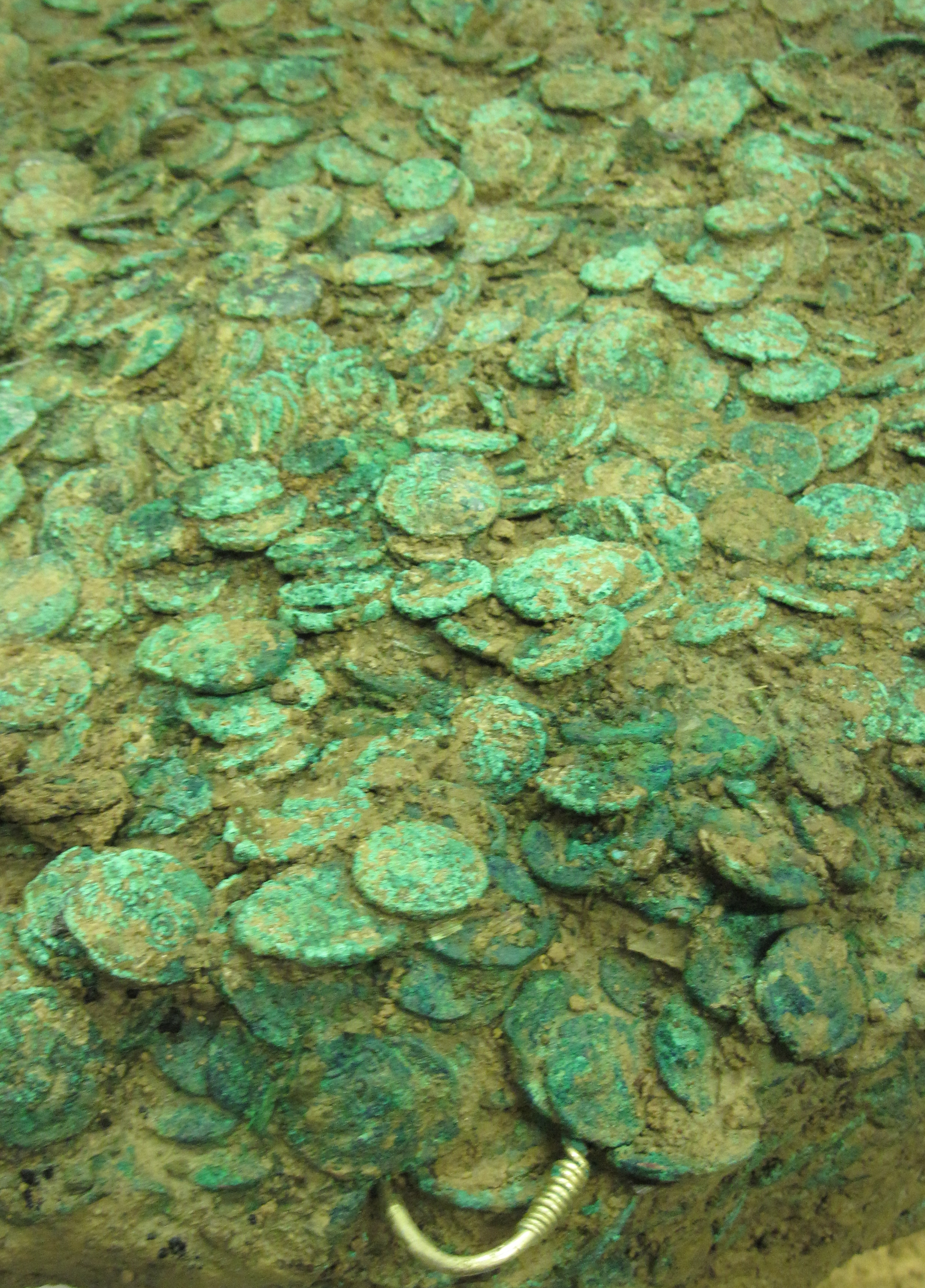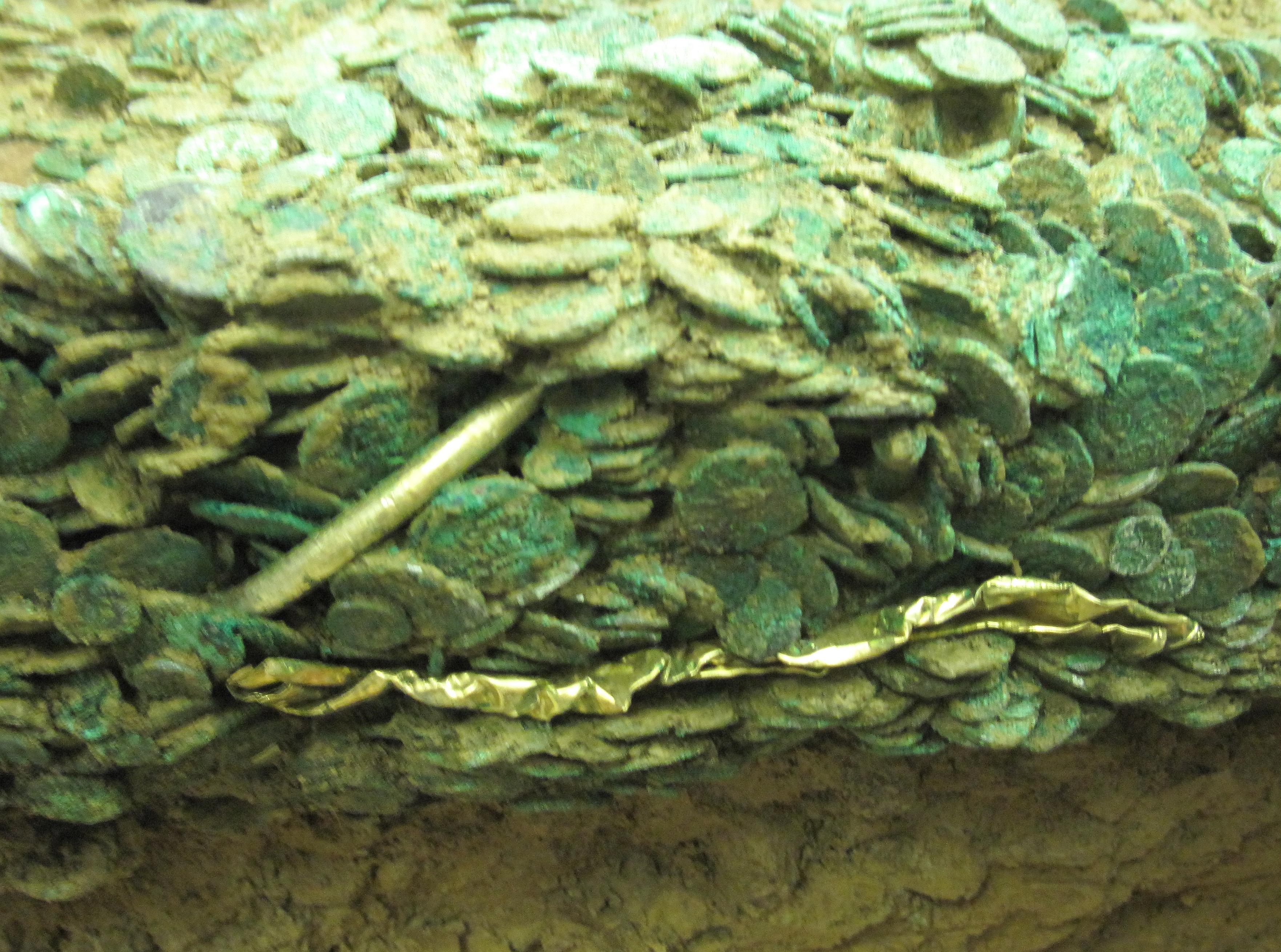Grouville Hoard on:
[Wikipedia]
[Google]
[Amazon]
 The Grouville Hoard is a
The Grouville Hoard is a
 Conservation and examination of the hoard is ongoing, and the individual items have so far been removed from the clay mass in which they were embedded. In addition to an estimated 70,000 Celtic and Roman silver coins, the hoard contains gold torcs, silver bracelets, gold sheet, fine silver wire, and a number of glass beads.
The hoard formed part of an exhibition at the Jersey Museum which ran from 26 May to 31 December 2014. As of 2015, the hoard is on display at
Conservation and examination of the hoard is ongoing, and the individual items have so far been removed from the clay mass in which they were embedded. In addition to an estimated 70,000 Celtic and Roman silver coins, the hoard contains gold torcs, silver bracelets, gold sheet, fine silver wire, and a number of glass beads.
The hoard formed part of an exhibition at the Jersey Museum which ran from 26 May to 31 December 2014. As of 2015, the hoard is on display at
 The Grouville Hoard is a
The Grouville Hoard is a hoard
A hoard or "wealth deposit" is an archaeological term for a collection of valuable objects or artifacts, sometimes purposely buried in the ground, in which case it is sometimes also known as a cache. This would usually be with the intention of ...
of an estimated 70,000 late Iron Age
The Iron Age is the final epoch of the three-age division of the prehistory and protohistory of humanity. It was preceded by the Stone Age (Paleolithic, Mesolithic, Neolithic) and the Bronze Age (Chalcolithic). The concept has been mostly appl ...
and Roman
Roman or Romans most often refers to:
*Rome, the capital city of Italy
*Ancient Rome, Roman civilization from 8th century BC to 5th century AD
*Roman people, the people of ancient Rome
*''Epistle to the Romans'', shortened to ''Romans'', a letter ...
coins reported in June 2012. They were discovered by metal detectorists Reg Mead and Richard Miles in a field at an undisclosed location in the parish of Grouville on the east side of Jersey
Jersey ( , ; nrf, Jèrri, label=Jèrriais ), officially the Bailiwick of Jersey (french: Bailliage de Jersey, links=no; Jèrriais: ), is an island country and self-governing Crown Dependencies, Crown Dependency near the coast of north-west F ...
in the Channel Islands
The Channel Islands ( nrf, Îles d'la Manche; french: îles Anglo-Normandes or ''îles de la Manche'') are an archipelago in the English Channel, off the French coast of Normandy. They include two Crown Dependencies: the Bailiwick of Jersey, ...
. It is the largest hoard ever found in Jersey, and the first major archaeological find made by metal detectorists in the island.
The hoard is thought to have belonged to a Curiosolitae
The Coriosolites or Curiosolitae were a Gallic people dwelling on the northern coast of present-day Brittany during the Iron Age and the Roman period.
Name
They are mentioned as ''Coriosolitas'' (var. ''coriosolitos'', ''curiosolitas'', ''curi ...
tribe fleeing Julius Caesar
Gaius Julius Caesar (; ; 12 July 100 BC – 15 March 44 BC), was a Roman general and statesman. A member of the First Triumvirate, Caesar led the Roman armies in the Gallic Wars before defeating his political rival Pompey in a civil war, and ...
's armies around 50 to 60 BC.
The find was the subject of a BBC Radio 4
BBC Radio 4 is a British national radio station owned and operated by the BBC that replaced the BBC Home Service in 1967. It broadcasts a wide variety of spoken-word programmes, including news, drama, comedy, science and history from the BBC' ...
programme in November 2021.
Discovery
Mead and Miles started metal detecting in the area where the hoard was reported in the early 1980s after they heard about a farmer who some years earlier had discovered a number of silver coins in an earthenware pot while pulling out a tree from ahedgerow
A hedge or hedgerow is a line of closely spaced shrubs and sometimes trees, planted and trained to form a barrier or to mark the boundary of an area, such as between neighbouring properties. Hedges that are used to separate a road from adjoini ...
. However, as they did not know the exact location of the find, and as the current owner of the farm would only allow them to metal detect once a year for 10–15 hours after the crops had been harvested, it took about 30 years before they eventually managed to locate the hoard.
In early 2012, Mead and Miles initially found 60 silver and one gold Iron Age coins, possibly minted by the Curiosolitae tribe at Saint-Malo
Saint-Malo (, , ; Gallo: ; ) is a historic French port in Ille-et-Vilaine, Brittany, on the English Channel coast.
The walled city had a long history of piracy, earning much wealth from local extortion and overseas adventures. In 1944, the Alli ...
in France. Subsequent detecting by Mead and Miles in the area of the initial find led them to discover a huge mass of Iron Age and Roman coins embedded in clay. The pair notified Jersey Heritage
Jersey Heritage is an independent trust in Jersey which is responsible for the island's major historic sites, museums, and public archives. It holds collections of artefacts, works of art, documents, specimens, and information relating to Jer ...
of the find, and in June 2012, archaeologists from the Société Jersiaise
The Société Jersiaise is a learned society in Jersey which was founded in 1873, in the manner of similar county societies in the United Kingdom and Sociétés Savantes in France for the purposes of:
*''"The Publication of Local History,
* ...
and Jersey Heritage, together with Celtic coin expert Philip de Jersey
Philip de Jersey is a Guernsey archaeologist and numismatist. He is known as an expert on Celtic coins of the Iron Age.
Life and career
De Jersey was born in Guernsey, and studied Geography at Hertford College, University of Oxford. After gr ...
, worked to remove the clay mass of coins, measuring 140×80×20 cm (55×31×8 in) and weighing about , which has since been taken to the Jersey Archive for cleaning and conservation.
Context
Excavation of the pit containing the large hoard has revealed evidence of timber posts, possibly from a hut, and large quantities of burnt daub and late Iron Age and early Roman pottery. The presence of slag and furnace linings along with some coins which have been cut in half, could suggest that the coins were being melted down. It may be that new coins were beingminted
Minted is an online marketplace of premium design goods created by independent artists and designers. The company sources art and design from a community of more than 16,000 independent artists from around the world. Minted offers artists two bus ...
here.
Conservation and display
 Conservation and examination of the hoard is ongoing, and the individual items have so far been removed from the clay mass in which they were embedded. In addition to an estimated 70,000 Celtic and Roman silver coins, the hoard contains gold torcs, silver bracelets, gold sheet, fine silver wire, and a number of glass beads.
The hoard formed part of an exhibition at the Jersey Museum which ran from 26 May to 31 December 2014. As of 2015, the hoard is on display at
Conservation and examination of the hoard is ongoing, and the individual items have so far been removed from the clay mass in which they were embedded. In addition to an estimated 70,000 Celtic and Roman silver coins, the hoard contains gold torcs, silver bracelets, gold sheet, fine silver wire, and a number of glass beads.
The hoard formed part of an exhibition at the Jersey Museum which ran from 26 May to 31 December 2014. As of 2015, the hoard is on display at La Hougue Bie
La Hougue Bie is a historic site, with museum, in the Jersey parish of Grouville. La Hougue Bie is depicted on the 2010 issue Jersey pound, Jersey 1 pound note.
Toponymy
''Hougue'' is a Jèrriais/Cotentin variant form of the more common Norm ...
Museum.
Valuation
The legal situation regarding the coins is unclear as the law of treasure trove may no longer be applicable in Jersey, and Jersey does not have a legal framework for dealing with treasure finds such as theTreasure Act 1996
The Treasure Act 1996 is a UK Act of Parliament, defining which objects are classified as treasure, legally obliging the finder to report their find.
Provisions
The Act is designed to deal with finds of treasure in England, Wales and Northern Ire ...
in the United Kingdom. The discovery has been reported to the Receiver General
A receiver general (or receiver-general) is an officer responsible for accepting payments on behalf of a government, and for making payments to a government on behalf of other parties.
See also
* Treasurer
* Receiver General for Canada
* Recei ...
of Jersey.
The two finders and the landowner made an agreement to share the proceeds of the hoard, and have indicated that they hope the coins will eventually be put on display at the Jersey Museum or Jersey Archive.
Philip de Jersey
Philip de Jersey is a Guernsey archaeologist and numismatist. He is known as an expert on Celtic coins of the Iron Age.
Life and career
De Jersey was born in Guernsey, and studied Geography at Hertford College, University of Oxford. After gr ...
, an expert on Celtic coins, has suggested that the coins could be valued at between £100 and £200 each, in which case the entire hoard may be worth between £7m and £14m.
Media
Mead was interviewed by Jane Garvey for "The Metal Detectorist, the Tip-Off and the 30-Year Quest", a November 2021 episode of herBBC Radio 4
BBC Radio 4 is a British national radio station owned and operated by the BBC that replaced the BBC Home Service in 1967. It broadcasts a wide variety of spoken-word programmes, including news, drama, comedy, science and history from the BBC' ...
series ''Life Changing'', about the find.
See also
*List of hoards in the Channel Islands
The list of hoards in the Channel Islands comprises significant archaeological hoards of coins, jewellery, precious and scrap metal objects and other valuable items discovered in the Channel Islands (Jersey, Guernsey, Alderney, Sark, Herm and ...
* Archaeology of the Channel Islands
Archaeology is promoted in Jersey by the '' Société Jersiaise'' and by Jersey Heritage. Promotion in the Bailiwick of Guernsey being undertaken by ''La Société Guernesiaise'', ''Guernsey Museums'', the ''Alderney Society'' with World War II wor ...
* Celtic coinage
Celtic coinage was minted by the Celts from the late 4th century BC to the mid 1st century AD. Celtic coins were influenced by trade with and the supply of mercenaries to the Greeks, and initially copied Greek designs, especially Macedonian coi ...
References
{{DEFAULTSORT:Grouville Hoard 2012 archaeological discoveries Metal detecting finds in the Channel Islands Grouville Archaeological sites in Jersey 2012 in Jersey Treasure troves in Jersey Coin hoards